Manitoba Insect & Disease Update
Issue 9: July 19, 2017
Summary
Insects:
Aphids have been a concern in some cereal and pea fields. Aphids have also been reported in corn, and isolated incidence of turnip aphids have been found in canola.
Thistle caterpillar and their webbing continue to be quite noticeable in some soybean fields, although caterpillars in some areas are turning to pupae.
There are some canola fields in the Central region where diamondback moth was getting close to the economic threshold.
Pathogens:
Blackleg and sclerotinia were reported at low levels in canola. Leaf lesions from blackleg were observed in the lower leaves in some fields.
Root rot was the most common disease reported in soybeans this week.
Root rots in Soybeans
Root rot in soybeans was reported. Soybean samples with suspected root rot symptoms were also received at the Crop Diagnostic Centre in Winnipeg. Fusarium spp was detected in most root rot suspected samples. However, other pathogens like Phytophthora sojae can also cause root rot in soybeans. When scouting for root rots, look for reddish-brown to brown lesions on the root and lower stem. The symptoms of P. sojae will be quite distinctive and appear as brown lesion on the lower stem extending upward from the soil line.
The prevalence of root rots may be higher in low lying areas, in areas of short crop rotation and rotations involving other susceptible hosts. A combination of seed treatment and resistance genetics (if available) may be helpful in minimizing prevalence of root rots.
The prevalence of root rots may be higher in low lying areas, in areas of short crop rotation and rotations involving other susceptible hosts. A combination of seed treatment and resistance genetics (if available) may be helpful in minimizing prevalence of root rots.
Aphids in Cereals
A few fields of wheat have had insecticides applied to control aphids.
One of the species present is English grain aphid which can often be found on the heads. The oat-birdcherry aphid is also present in some fields; this species prefers the stems and lower leaves.
The economic threshold for aphids on cereals is an average of 12 to 15 aphids per stem prior to the soft dough stage. After the early dough stage insecticide treatments would not be cost-effective.
The economic threshold presented is a range and there are factors such as weather conditions, dominant species of aphid present, and natural enemies that determine how economical a given population of aphids ends up being. For example, research found that greenbugs and oat-birdcherry aphid were more damaging than English grain aphid at similar population densities. Research on English grain aphid feeding on winter wheat found that there was a greater yield reduction for a given aphid density when plants were grown under severe water stress than nonstress conditions.
Several people have noted high levels of hover fly larvae in with the aphids. Hover fly larvae are quite good aphid predators. Aphid mummies, the remains of parasitized aphids have also been noticed as well.
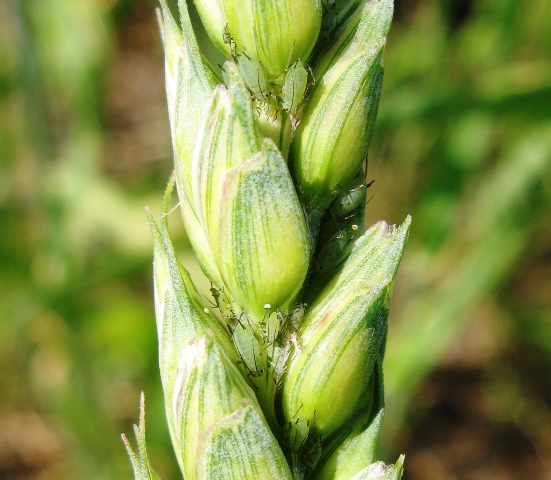
Figure 1. Aphids on wheat
Aphids in Peas
Some insecticide applications have also occurred for aphids on peas in western Manitoba and the Interlake. The economic threshold for aphids in peas is if at the beginning of flowering there are 9 to 12 aphids per sweep or on average 2 -3 aphids per 20 cm of plant tip, an insecticide application when 50% of plants have produced some young pods would be cost-effective. Most of the damage that aphids do to peas is to the pods before they start to fill. If you think that most of the pods have already started to fill, spraying would be too late and would not be economical.
Small orange butterflies in crops
Some have been asking about small orange butterflies they are seeing coming to many flowering crops. This is European skipper (Thymelicus lineola).
The adult skippers are not a pest of anything, although you may see them on a lot of things. Adult skippers feed on nectar, and can be considered pollinators of flowers. They may fly in large groups, and at times can be extremely numerous. 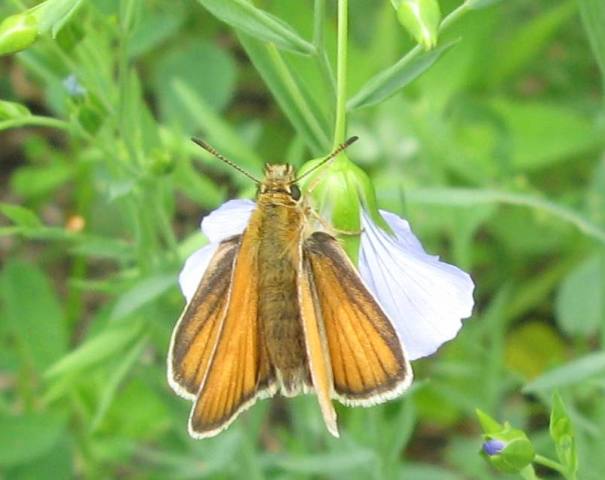
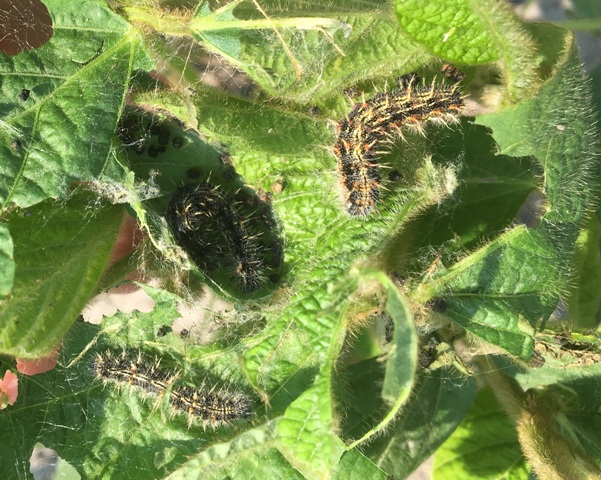
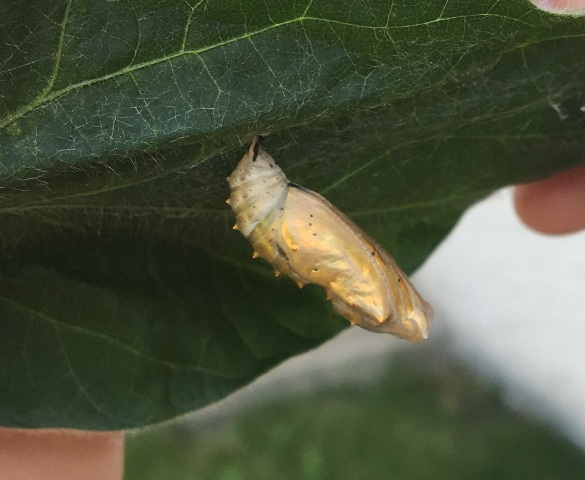
Figure 3. Thistle caterpillars on soybeans Figure 4. Thistle caterpillar pupa
The adult skippers are not a pest of anything, although you may see them on a lot of things. Adult skippers feed on nectar, and can be considered pollinators of flowers. They may fly in large groups, and at times can be extremely numerous.
The preferred food of the larvae is timothy, but some other grasses may also be hosts. They are generally not economic pests of timothy, but are something that is good to scout for early in the growing season. They just have 1 generation per year, so because they have moved into the adult stage primarily the larval stage would be done for this year.
The adult skippers are often flying until about the end of the first week in August.
This is an introduced species, accidentally introduced to North America in 1910 at London, Ontario. They were first seen in Manitoba in 1972.
This is an introduced species, accidentally introduced to North America in 1910 at London, Ontario. They were first seen in Manitoba in 1972.

Figure 2. European Skipper
Thistle Caterpillar Update
The thistle caterpillar larvae that have been quite noticeable in some soybean and sunflower fields, in addition to on thistles, are starting to turn to pupae. So the populations of caterpillars have started to decline, and many should turn to pupae over the next week.


Figure 3. Thistle caterpillars on soybeans Figure 4. Thistle caterpillar pupa
Insect Monitoring Programs
Bertha Armyworm: Most cumulative counts from traps for bertha armyworm are currently still all in the low risk range (less than 300). Two traps from western Manitoba have counts in the uncertain risk range.
Levels of larvae of bertha armyworm can vary greatly between fields within a region, and should higher levels of larvae occur in a region these higher levels of larvae may not be in the same fields as traps with the highest counts This is due to the stage of the crop at the time of egg laying and other factors. Thus the data from these traps should not be used to make control decisions for bertha armyworm, but to encourage enhanced scouting for larvae in regions with higher trap counts.
Highest counts so far are:
Table 1. Highest cumulative trap counts for bertha armyworm adults over the trapping period June 4 to July 19, 2017.
0-300=low risk 300-900=uncertain risk 900-1,200=moderate risk 1,200+=high risk
| Location | Region | Count | Risk |
|---|---|---|---|
| Tilston | Southwest | 379 | Uncertain |
| Durban | Northwest | 312 | Uncertain |
| Benito | Northwest | 289 | Low |
| Benito | Northwest | 277 | Low |
| Napinka | Southwest | 267 | Low |
| Roblin | Northwest | 237 | Low |
A more detailed update of bertha armyworm counts in Manitoba is available on the Manitoba Agriculture website at: http://www.gov.mb.ca/agriculture/crops/insects/bertha-armyworm-forecast.html
Insect Identification Quiz
The insects in the following 2 photos were all found on wheat, that coincidentally also had noticeable levels of aphids. What are the 3 insects in figure 5, and the 3 light brown things in figure 6 that look like inflated aphids?
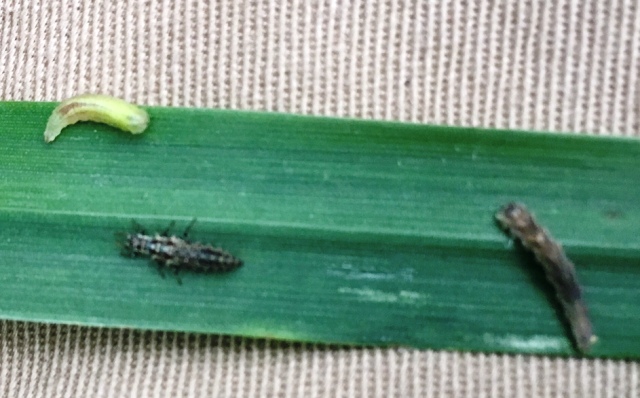
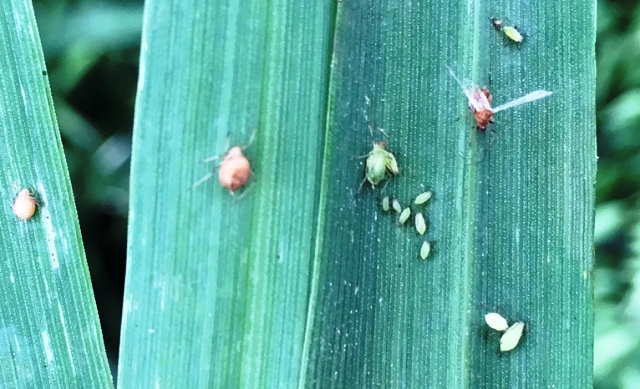
Figure 5. Figure 6.
Figures 5 and 6 from Cameron Hildebrand
The green slug-like insect at the top of figure 5 is a hover fly larva. The brown slug-like larva on the right in figure 5 is also a hover fly larva. There are many species of hover flies, and the appearance of the larvae can differ. They are very good aphid predators. They are fun to watch feed as well. They will impale an aphid with their hook-like mouthpart, raise it up, and suck the juice out of the aphid. You can see the aphid deflating as they do this. They will then put the aphid remains down, and tap around for another aphid to impale.
The brown, alligator-shaped insect on the bottom left in figure 5 is a lacewing larvae. They are generalist predators and eat many different types of insects. They will also consume a lot of aphids.
The light-brown aphid-like things in figure 6 are aphid mummies. These are the remains of aphids that had been parasitized. Very small wasps (that do not sting people) would have been flying around laying eggs into aphid. When the wasp eggs hatch, their larvae live inside the aphid, eventually killing it. The remains of the aphid become a convenient home for the wasp, which complete their larval development, turn into a pupa, and eventually become an adult wasp and leave their aphid home. If you look carefully at aphid mummies you can often see a hole where they have exited their aphid home.
So when you are out scouting fields, you re not the only one looking for aphids; if your lucky you may get to see one of these feeding show.
So when you are out scouting fields, you re not the only one looking for aphids; if your lucky you may get to see one of these feeding show.
----------------------------------------------------------------------------------------------------------------------
Compiled by:
John Gavloski, Entomologist Holly Derksen, Field Crop Pathologist
Manitoba Agriculture Manitoba Agriculture
Phone: (204) 750-0594 Phone: (204) 750-4248
To report observations on insects or plant pathogens that may be of interest or importance to farmers and agronomists in Manitoba, please send messages to the above contacts.
To be placed on an E-mail list so you will be notified immediately when new Manitoba Insect and Disease Updates are posted, please contact John Gavloski at the address or numbers listed above.

